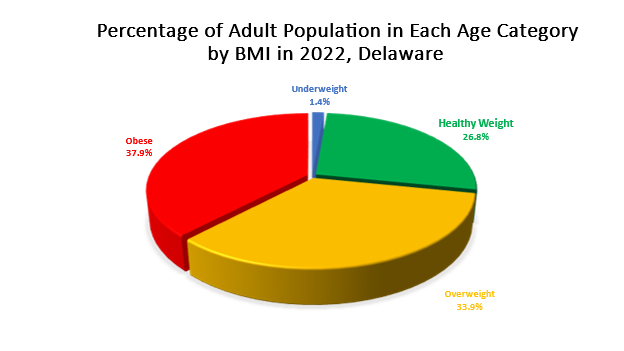Current Suspected Overdose Deaths in Delaware for 2025: Get Help Now!
Find school water testing results and additional resources
Attention Medicaid Participants: Eligibility Renewals Restarted April 1, 2023
More than one-third of Delaware adults reported a Body Mass Index (BMI) considered "obese" in the 2022 Delaware Behavioral Risk Factor Survey (BRFS).
The survey asks respondents for their height and weight, from which BMI is calculated. BMI, while not the ideal measure for individuals, is an appropriate measure for large population studies. In 2022, 37.9 percent of Delaware adults reported being obese, and another 33.9 percent reported BMIs considered "overweight" — more than the recommended weight levels, but not obese. About 26.8 percent of adults in Delaware reported weights in the recommended or healthy range. The pie chart below shows adult prevalence by BMI category:

Source: Delaware Health & Social Services, Division of Public Health, Behavioral Risk Factor Survey (BRFS), 2022.
Obesity is a major public health problem, according to the U.S. Centers for Disease Control and Prevention (CDC). Obesity (a BMI greater than 30) increases the risk of chronic diseases and other health conditions, including: heart disease, stroke, high blood pressure, high cholesterol, liver and gall bladder disease, sleep apnea, joint problems, and infertility.
There was no statistically significant difference for obesity prevalence between men and women. Forty nine percent of Non-Hispanic Black adults reported obese BMIs, compared to 35.5 percent of Non-Hispanic white adults, and 35.4 percent of Latino/Hispanic adults.
The BRFS also shows that obesity prevalence increases with age. Only 28.0 percent of adults ages 18-34 are obese, compared to 44.6 percent of adults ages 45-54.
During the twenty-year period from 1990 to 2010, obesity prevalence among Delaware adults doubled from 14.4 percent in 1990 to 28.7 percent in 2010. However, since 2011 the obesity prevalence has increased to 37.9 percent in 2022. Likewise, the prevalence of overweight has remained relatively level since 2018 (see chart below).
| Weight | 2012 | 2013 | 2014 | 2015 | 2016 | 2017 | 2018 | 2019 | 2020 | 2021 | 2022 |
|---|---|---|---|---|---|---|---|---|---|---|---|
| Overweight | 39.1% | 33.5% | 36.8% | 37.2% | 37.3% | 36.7% | 34.3% | 34.5% | 32.1% | 34.9% | 33.9% |
| Obese | 27.0% | 31.0% | 30.7% | 29.7% | 30.7% | 31.8% | 33.5% | 34.4% | 36.5% | 33.9% | 37.9% |
Source: Delaware Health & Social Services, Division of Public Health, Behavioral Risk Factor Survey (BRFS), 2012-2022.
Overweight and obesity are major contributing factors for developing diabetes. In Delaware, 23.9 percent of adults who report being obese have been diagnosed with diabetes, compared with 5.3 percent of adults who report normal weights. About 89.3 percent of adults with diagnosed diabetes are either overweight or obese.
Obesity among Delaware adults more than doubled between 1992 and 2021 to 37.9 percent in 2022. The prevalence of diagnosed diabetes among Delaware adults also more than doubled from 4.9 percent in 1991 to 13.9 percent in 2022.
Demographic factors for diabetes closely parallel the factors related to overweight and obesity. Adults with lower educational levels and low income have higher prevalence of both obesity and diabetes.
The Division of Public Health also conducts the school-based Youth Risk Behavior Survey (YRBS) of Delaware public high school students. In 2021, 17.0 percent of Delaware public high school students reported BMIs considered obese. At the high school level, males (20.6 percent) have a higher obesity prevalence than females (13.2 percent). Prevalence is slightly higher among black or African American students (24.3 percent) than Hispanic students (18.5 percent) or white students (11.9 percent). Obesity prevalence for high school students has increased 70% over the last 11 years.
Another 15.4 percent of Delaware public high school students report being overweight, but not obese. Female students have a slightly higher prevalence of overweight, but the difference is not statistically significant.
Weight is influenced by a variety of factors, including physical activity levels, diet, and genetics. What we eat and our levels of physical activity are keys to maintaining or achieving a healthy weight and being physically fit. Public Health experts at the U.S. Centers for Disease Control and Prevention (CDC) have published recommendations for physical activity. They recommend that children and youth get at least 60 minutes of physical activity a day on at least five days of every week. Adults should do at least 30 minutes of moderate or vigorous aerobic physical activity every day. Additional health benefits are provided by increasing time up to 60 minutes a day. Adults should also do muscle-strengthening activities that involve all the major muscle groups on 2 or more days a week.
As would be expected, youth are physically more active than adults. According to the 2021 Youth Risk Behavior Survey (YRBS), 41.2 percent of Delaware public high school students reported an hour of physical activity a day on five or more days of the week.
The BRFS uses a formula, based on a set of eight questions, to determine what percentage of the adult population meets recommendations for exercise and physical activity. In 2022, 76.5 percent of adults reported doing physical activity or exercise during the past 30 days other than their regular job.
DPH promotes healthy eating and physical activity through a Healthy Lifestyles campaign, which links unhealthy eating and lack of exercise to chronic illnesses and disease, like cancer, heart disease, diabetes, and obesity. The campaign encourages Delawareans to make better choices to reduce the risk of these chronic diseases, and improve overall health.
 Healthy Eating and Nutritional Risk Factors
Healthy Eating and Nutritional Risk FactorsWhat we eat or drink also can put us at greater risk for obesity—or help protect us from related health problems.
5-2-1-Almost None is a daily formula aimed at developing good habits among children and youth. The campaign stands for eating 5 or more vegetables and fruits each day, trying to limit leisure screen time to 2 hours a day, being physically active for at least 1 hour a day, and consuming no or “almost no” sugar-sweetened beverages. These are generally good goals for adults as well.
Unfortunately, 2021 BRFS data show that Delaware adults do not come close to the goal of five or more fruits and vegetables a day. Only about 15.0 percent of Delaware adults report drinking fruit juice once or twice a day. Only 48.9 percent of adults report eating fruit once or twice a day; and about half (44.6 percent) report eating vegetables other than potatoes once or twice a day.
Five-a-Day
The Delaware BRFS uses a formula to determine what percentage of the state's adults eat the recommended five fruits and/or vegetables a day. In 2021, only 13.1 percent of Delaware adults reported eating any combination of five fruits and vegetables per day on a regular basis. While this is a decrease from 15.5 percent in 2017, this is not a statistically significant difference.
Sugar-Sweetened Beverages
Data on consumption of sugar-sweetened beverages show that fewer than half the state's adults drink no sugar-sweetened beverages. In 2017, the most recent year these data were collected, 41.2 percent of Delaware adults reported that they "never" drink sodas that contain sugar. The prevalence of this healthy behavior is significantly higher among women. While only 35.9 percent of men said they do not consume sugar-sweetened soda, 45.8 percent of women avoid sugary soda. The BRFS also asks about consumption of other sugar-sweetened beverages, such as lemonade, sweet tea, and sports or energy drinks. In 2017, nearly half (49.2 percent) of Delaware adults reported they never drink these other sugar-sweetened beverages. Again, prevalence of this positive behavior was significantly higher among women (53.9 percent) than among men (43.8 percent).
A printer-friendly PDF version of this page is available here.
Return to the Main Delaware BRFS Page.
![]() Please note: Some of the files available on this page are in Adobe PDF format which requires Adobe Acrobat Reader. A free copy of Adobe Acrobat Reader can be downloaded directly from Adobe . If you are using an assistive technology unable to read Adobe PDF, please either view the corresponding text only version (if available) or visit Adobe's Accessibility Tools page.
Please note: Some of the files available on this page are in Adobe PDF format which requires Adobe Acrobat Reader. A free copy of Adobe Acrobat Reader can be downloaded directly from Adobe . If you are using an assistive technology unable to read Adobe PDF, please either view the corresponding text only version (if available) or visit Adobe's Accessibility Tools page.